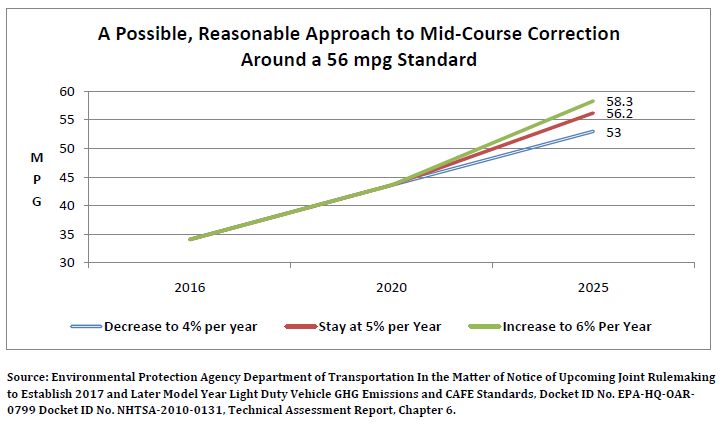Washington, D.C. – Recently, the Consumer Federation of America (CFA) supported a 56 mpg standard as the lowest level that should be considered for the 2025 fuel economy standard because the 56 mpg standard (as modeled by EPA-NHTSA in their Notice of Intent) provides both the appropriate level of consumer benefits and enables the auto industry to respond in a reasonable and gradual manner. While the target level is important, the trajectory on which that level is achieved is equally, if not more important. “We have repeatedly emphasized the importance of the gradual, long term approach because it allows consumers and the auto industry to adjust over time, while providing certainty about the future standard,” said Jack Gillis, CFA’s Director of Public Affairs and author of The Car Book.
“The administration should reject the auto industry’s ‘slow-lane, off-ramp’ proposal for fuel economy standards because it undermines the essential nature of the program and will rob consumers and the nation of vital benefits,” said Dr. Mark Cooper, CFA’s Director of Research. The “slow-lane, off-ramp” proposal will:
- lower consumers savings by at least $50 billion;
- increase gasoline consumption and oil imports by hundreds of millions of barrels; and, reduce employment in the auto sector by at least 50,000 jobs.
Press accounts indicate that the automakers are pushing a “slow-lane, off-ramp” approach that moves slowly in the early years and more swiftly in the later years and allows an off ramp that would lower the standards significantly. “That approach creates a speed trap that will kill the program. Our analysis shows that in order to catch up, after a short four year period of slow improvements, it would require a sharp increase in the rate of improvement to almost 7% per year,” said Cooper.
The more likely outcome is the industry, having invested to meet only the 3% rate will demand an off-ramp rate that stays at 3%. “We believe alternative approaches that move slowly in the early years and swiftly in the later years, will create pressure for future decisions to lower the standards, which will significantly undermine the consumer benefits of the standard and place the U.S. car companies in a non-competitive position, destroying the essential characteristics of the program,” said Gillis
Using the projections from the Notice of Intent, published by EPA and NHTSA, the following chart compares the results of three possible approaches. As is evident, a standard that would require a 3% per year improvement from 2016 to2020 would require a sharp increase in the rate of improvement to almost 7% per year for 2021 and later. Requiring such a dramatic change “mid-stream” would prove to be enormously challenging to the car companies and likely result in strong arguments for continuing at the lower percentage rate of improvement. It is naïve – even foolish – to think the industry that will not accept a steady 5% increase today will embrace a 7% rate of increase in ten years.

The bottom line, consumers would lose out on billions of dollars in savings and the U.S. car companies would find themselves in a very non-competitive position both in the U.S. and globally. The U.S. has seen this lack of competitiveness before and the results were disastrous.

The idea of a mid-course correction is not unreasonable, but it should not undermine the integrity of the program. In fact, we are convinced that once the car companies see that a gradual 5% increase has many benefits, then a strong argument to increase the percentage will be made. A reasonable approach would be to start with the 5%-56 mpg scenario and then consider a 1% per year decrease or increase in the rate of improvement. As the following figure shows, this would establish a range of possible target for 2025 between 53 and 58.2 mpg.

The mid-course evaluation should be based on actual performance through 2020, which means it would not be conducted until the data became available, which would likely be in late 2021 or early 2022. This would preserve the long-term, gradual nature of the program and keep the target high, while affording the opportunity for an adjustment.
This is a critical decision point for the President. In approaching this standard from a consumer perspective, we have proven that a gradual increase provides the most consumer benefits. What is particularly significant about this approach is that we have been sensitive to the needs and challenges facing the auto industry—and this is good for them as well. Historically, the car companies have resisted change always saying that the costs will out way any benefits. Like in the past, their concerns are enormously exaggerated and like in the past the new standard will open doors, increase sales, and keep the U.S. automakers from again falling behind their increasingly stronger global competitors. 56 mpg by 2025 is reasonable, achievable and in the best interests of, both, the consumer and the industry.

